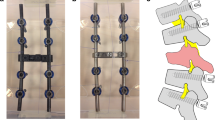Abstract
Intervertebral spacers for anterior spine fusion are made of different materials, such as titanium, carbon or cobalt-chrome, which can affect the post-fusion MRI scans. Implant-related susceptibility artifacts can decrease the quality of MRI scans, thwarting proper evaluation. This cadaver study aimed to demonstrate the extent that implant-related MRI artifacting affects the post-fusion evaluation of intervertebral spacers. In a cadaveric porcine spine, we evaluated the post-implantation MRI scans of three intervertebral spacers that differed in shape, material, surface qualities and implantation technique. A spacer made of human cortical bone was used as a control. The median sagittal MRI slice was divided into 12 regions of interest (ROI). No significant differences were found on 15 different MRI sequences read independently by an interobserver-validated team of specialists (P>0.05). Artifact-affected image quality was rated on a score of 0-1-2. A maximum score of 24 points (100%) was possible. Turbo spin echo sequences produced the best scores for all spacers and the control. Only the control achieved a score of 100%. The carbon, titanium and cobalt-chrome spacers scored 83.3, 62.5 and 50%, respectively. Our scoring system allowed us to create an implant-related ranking of MRI scan quality in reference to the control that was independent of artifact dimensions. The carbon spacer had the lowest percentage of susceptibility artifacts. Even with turbo spin echo sequences, the susceptibility artifacts produced by the metallic spacers showed a high degree of variability. Despite optimum sequencing, implant design and material are relevant factors in MRI artifacting.




Similar content being viewed by others
References
Bader R, Steinhauser E, Rechl H, Siebels W, Mittelmeier W, Gradinger R (2003) Carbon fiber-reinforced plastics as implant materials. Orthopade 32:32–40
Brantigan JW, Steffee AD (1993) A carbon fiber implant to aid interbody lumbar fusion. Two-year clinical results in the first 26 patients. Spine 18:2106–2107
Fellner C, Behr M, Fellner F, Held P, Handel G, Feuerbach S (1997) Artifacts in MR imaging of the temporomandibular joint caused by dental alloys: a phantom model study at T1.5. Rofo 166:421–428
Fritzsche S, Thull R, Haase A (1994) Reduction of artifacts in magnetic resonance images by using optimized materials for diagnostic devices and implants. Biomed Tech (Berl) 39:42–46
Goulet JA, Senunas LE, DeSilva GL, Greenfield ML (1997) Autogenous iliac crest bone graft. Complications and functional assessment. Clin Orthop 339:76–81
Henk CB, Brodner W, Grampp S, Breitenseher M, Thurnher M, Mostbeck GH, Imhof H (1999) The postoperative spine. Top Magn Reson Imaging 10:247–264
Herold T, Caro WC, Heers G, Perlick L, Grifka J, Feuerbach S, Nitz W, Lenhart M (2004) Influence of sequence type on the extent of the susceptibility artifact in MRI—a shoulder specimen study after suture anchor repair. Rofo 176:1296–1301
Malik AS, Boyko O, Atkar N, Young WF (2001) A comparative study of MR imaging profile of titanium pedicle screws. Acta Radiol 42:291–293
Ortiz O, Pait TG, McAllister P, Sauter K (1996) Postoperative magnetic resonance imaging with titanium implants of the thoracic and lumbar spine. Neurosurgery 38:741–745
Petersilge CA, Lewin JS, Duerk JL, Yoo JU, Ghaneyem AJ (1996) Optimizing imaging parameters for MR evaluation of the spine with titanium pedicle screws. AJR Am J Roentenol 166:1213–1218
Rudisch A, Kremser C, Peer S, Kathrein A, Judmaier W, Daniaux H (1998) Metallic artifacts in magnetic resonance imaging of patients with spinal fusion. A comparison of implant materials and implant sequences. Spine 23:692–699
Rupp R, Ebraheim NA, Savolaine ER, Jackson WT (1993) Magnetic resonance imaging evaluation of the spine with metal implants. General safety and superior imaging with titanium. Spine 18:379–385
Schenck JF (1996) The role of magnetic susceptibility in magnetic resonance imaging: MRI magnetic compatibility of the first and second kinds. Med Phys 23:815–850
Summers BN, Eisenstein SM (1989) Donor site pain from the ilium. A complication of lumbar spine fusion. J Bone Joint Surg Br 71:677–680
Thomsen M, Schneider U, Breusch SJ, Hansmann J, Freund M (2001) Artefacts and ferromagnetism dependent on different metal alloys in magnetic resonance imaging. An experimental study. Orthopade 30:540–544
Vaccaro AR, Chesnut RM, Scuderi G, Healy JF, Massie JB, Garfin SR (1994) Metallic spinal artifacts in magnetic resonance imaging. Spine 19:1237–1242
Van Goethem JW, Parizel PM, Jinkins JR (2002) Review article: MRI of the postoperative lumbar spine. Neuroradiology 44(9):723–739
Wang JC, Sandhu HS, Yu MD, Minchew JT, Delamarter RB (1997) MR parameters for imaging titanium spinal instrumentation. J Spinal Disord 10:27–32
Wang JC, Yu WD, Sandhu HS, Tam V, Delamarter RB (1998) A comparison of magnetic resonance and computed tomographic image quality after the implantation of tantalum and titanium spinal instrumentation. Spine 23:1684–1688
Weiner BK, Fraser RD (1998) Spine update lumbar interbody cages. Spine 23:634–640
Author information
Authors and Affiliations
Corresponding author
Rights and permissions
About this article
Cite this article
Ernstberger, T., Heidrich, G., Bruening, T. et al. The interobserver-validated relevance of intervertebral spacer materials in MRI artifacting. Eur Spine J 16, 179–185 (2007). https://doi.org/10.1007/s00586-006-0064-5
Received:
Revised:
Accepted:
Published:
Issue Date:
DOI: https://doi.org/10.1007/s00586-006-0064-5




